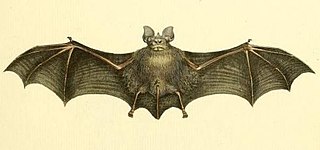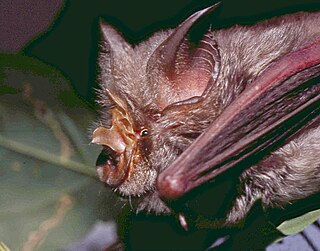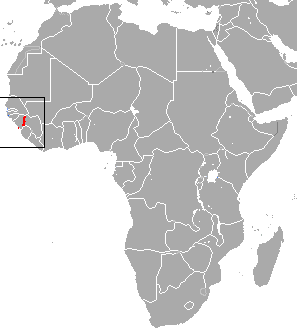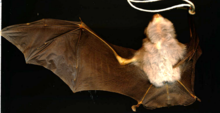
Horseshoe bats are bats in the family Rhinolophidae. In addition to the single living genus, Rhinolophus, which has about 106 species, the extinct genus Palaeonycteris has been recognized. Horseshoe bats are closely related to the Old World leaf-nosed bats, family Hipposideridae, which have sometimes been included in Rhinolophidae. The horseshoe bats are divided into six subgenera and many species groups. The most recent common ancestor of all horseshoe bats lived 34–40 million years ago, though it is unclear where the geographic roots of the family are, and attempts to determine its biogeography have been indecisive. Their taxonomy is complex, as genetic evidence shows the likely existence of many cryptic species, as well as species recognized as distinct that may have little genetic divergence from previously recognized taxa. They are found in the Old World, mostly in tropical or subtropical areas, including Africa, Asia, Europe, and Oceania.

The lesser horseshoe bat is a type of small European and North African insectivorous bat, related to its larger cousin, the greater horseshoe bat. As with all horseshoe bats, the species gets its name from its distinctive horseshoe-shaped noseleaf.

The halcyon horseshoe bat is a species of bat in the family Rhinolophidae. It is found in Cameroon, Republic of the Congo, Democratic Republic of the Congo, Ivory Coast, Equatorial Guinea, Ghana, Guinea, Kenya, Liberia, Nigeria, Senegal, South Sudan, Togo, Uganda, possibly Gabon, and possibly Sierra Leone. Its natural habitats are subtropical and tropical dry and moist lowland forest, moist savanna, caves, and other subterranean habitats.

Geoffroy's horseshoe bat is a species of bat in the family Rhinolophidae found in Africa. Its natural habitats are subtropical or tropical moist lowland forest, Mediterranean-type shrubby vegetation, caves and other subterranean habitats, and hot deserts.

Decken's horseshoe bat is a species of horseshoe bat. It is found in Kenya and Tanzania. Its natural habitats are tropica and subtropical moist lowland and montane forest, moist savanna, caves and other subterranean habitats.

The Mediterranean horseshoe bat is a species of insectivorous bat in the family Rhinolophidae. It is found in the Mediterranean region and Balkan peninsula, as well as parts of Italy.

Rüppell's horseshoe bat is a species of bat in the family Rhinolophidae found in Africa. Its natural habitats are subtropical or tropical dry forests, savanna, caves and other subterranean habitats. This species is quite common in parts of its range, and no specific threats have been recognised, so the International Union for Conservation of Nature has rated its conservation status as being of "least concern".

The Guinean horseshoe bat is a species of bat in the family Rhinolophidae. It is found in Ivory Coast, Guinea, Liberia, Senegal, and Sierra Leone. Its natural habitats are subtropical and tropical forests, moist savanna, caves, and other subterranean habitats.

The Hills' horseshoe bat is a species of bat in the family Rhinolophidae. It is found in Cameroon, Guinea, Liberia, and Nigeria. Its natural habitats are subtropical and tropical moist lowland and montane forest, caves and other subterranean habitats.

Maclaud's horseshoe bat is a species of bat in the family Rhinolophidae. It is endemic to Guinea. Its natural habitats are moist savanna, caves and other subterranean habitats. It is one of five African microbat species to be listed as endangered by the IUCN. In 2013, Bat Conservation International listed this species as one of the 35 species of its worldwide priority list of conservation. It is threatened by habitat loss.

The Ziama horseshoe bat is a species of bat in the family Rhinolophidae. It was first described in 2002. It is found in Guinea, Sierra Leone, and Liberia. Its natural habitats are subtropical and tropical moist lowland and monstane forests. In 2013, Bat Conservation International listed this species as one of the 35 species of its worldwide priority list of conservation.












